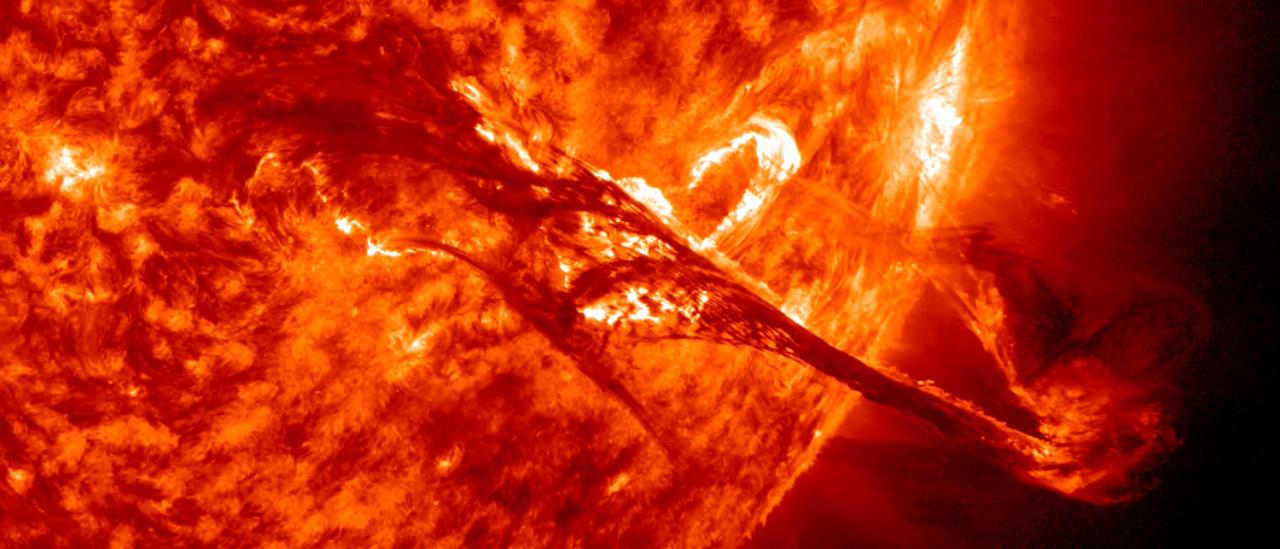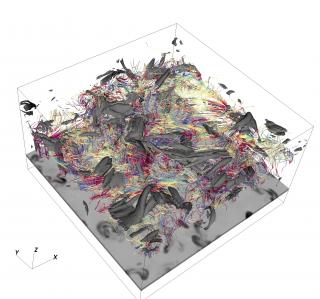Subvenciones relacionadas:
General
Los campos magnéticos son uno de los ingredientes fundamentales en la formación de estrellas y su evolución. En el nacimiento de una estrella, los campos magnéticos llegan a frenar su rotación durante el colapso de la nube molecular, y en el fin de la vida de una estrella, el magnetismo puede ser clave en la forma en la que se pierden las capas externas de forma dramática. En la vida adulta, el magnetismo da lugar a la actividad de las estrellas. Nuestro Sol tiene campos magnéticos que dan lugar a una actividad tan espectacular que es capaz de tener un impacto en la Tierra. Pero en otras estrellas, la actividad magnética es, en algunos casos, órdenes de magnitud más intensa que la solar, influenciando drásticamente el transporte de especies químicas y de momento angular, así como afectando posibles sistemas planetarios alrededor de éstas.
La finalidad de este Proyecto es estudiar diversas manifestaciones del campo magnético que se pueden observar en la atmosfera solar y en otras estrellas. Estas incluyen estructuras tan diversas como las manchas solares, los campos débiles presentes en el sol en calma o estructuras cromosféricas y coronales como los filamentos y las protuberancias. Así, se han ido abordando gradualmente los siguientes temas de investigación:
Magnetismo solar
- Estructura y evolución del campo magnético en manchas solares.
- Estructura y evolución del campo magnético en el Sol en calma.
- Estructura y evolución del campo magnético en la cromosfera y en estructuras cromosféricas (protuberancias, espículas,...)
- Estructura y evolución del campo magnético en bucles coronales.
- Estructura y evolución del campo magnético global del Sol. Estudios del ciclo de actividad magnética.
- Estudio empírico de la propagación de ondas magnetohidrodinámicas en el seno de estructuras magnéticas.
- Estudio empírico de mecanismos relacionados con el calentamiento de las capas externas del Sol.
- Estudio empírico de la influencia de la ionización parcial en la dinamica de la atmosfera solar.
- Implicación en el proyecto del Telescopio Solar Europeo.
Magnetismo estelar
- Desarrollo de métodos numéricos para el diagnóstico del campo magnético estelar, tanto en la superficie como en la cromosfera.
- Estudio del magnetismo en protuberancias estelares.
- Impacto del campo magnético en las últimas fases de la evolución estelar.
Miembros
Resultados
- Ondas espirales en manchas solares: Se han interpretado como ondas magnetoacústicas que se propagan desde el interior hasta capas atmosféricas siguiendo la dirección del campo magnético. Se ha caracterizado la topología del campo magnético de la mancha, descartando que la forma espiral sea consecuencia del retorcimiento de las líneas de campo (Felipe et al. 2019).
- Respuesta magnética a umbral flashes: Observaciones espectropolarimétricas simultáneas de las líneas cromosféricas He I 10830 y Ca II 8542 fueron usadas para estimar las fluctuaciones del campo magnético asociado a ondas de choque. Los choques provocan la expansión de las líneas de campo (Houston et al. 2018, incluye a A. Asensio Ramos).
Actividad científica
Publicaciones relacionadas
-
Two-fluid simulations of waves in the solar chromosphere. I. Numerical code verification
Solar chromosphere consists of a partially ionized plasma, which makes modeling the solar chromosphere a particularly challenging numerical task. Here we numerically model chromospheric waves using a two-fluid approach with a newly developed numerical code. The code solves two-fluid equations of conservation of mass, momentum, and energy, together
Popescu Braileanu, B. et al.Fecha de publicación:
72019 -
Stokes inversion based on convolutional neural networks
Context. Spectropolarimetric inversions are routinely used in the field of solar physics for the extraction of physical information from observations. The application to two-dimensional fields of view often requires the use of supercomputers with parallelized inversion codes. Even in this case, the computing time spent on the process is still very
Asensio Ramos, A. et al.Fecha de publicación:
62019 -
Spectropolarimetric analysis of an active region filament. I. Magnetic and dynamical properties from single component inversions
Aims: The determination of the magnetic filed vector in solar filaments is made possible by interpreting the Hanle and Zeeman effects in suitable chromospheric spectral lines like those of the He I multiplet at 10 830 Å. We study the vector magnetic field of an active region filament (NOAA 12087). Methods: Spectropolarimetric data of this active
Díaz Baso, C. J. et al.Fecha de publicación:
52019 -
Spectropolarimetric analysis of an active region filament.. II. Evidence of the limitations of a single-component model
Aims: Our aim is to demonstrate the limitations of using a single-component model to study the magnetic field of an active region filament. To do this, we analyzed the polarimetric signals of the He I 10830 Å multiplet, which were acquired with the infrared spectrograph GRIS of the GREGOR telescope (Tenerife, Spain). Methods: After a first analysis
Díaz Baso, C. J. et al.Fecha de publicación:
52019 -
Inference of magnetic field strength and density from damped transverse coronal waves
A classic application of coronal seismology uses transverse oscillations of waveguides to obtain estimates of the magnetic field strength. The procedure requires information on the density of the structures. Often it ignores the damping of the oscillations. We computed marginal posteriors for parameters such as the waveguide density, the density
Arregui, I. et al.Fecha de publicación:
52019 -
Chromospheric polarimetry through multiline observations of the 850 nm spectral region III: Chromospheric jets driven by twisted magnetic fields
We investigate the diagnostic potential of the spectral lines at 850 nm for understanding the magnetism of the lower atmosphere. For that purpose, we use a newly developed 3D simulation of a chromospheric jet to check the sensitivity of the spectral lines to this phenomenon as well as our ability to infer the atmospheric information through
Quintero Noda, C. et al.Fecha de publicación:
72019 -
High-resolution spectroscopy of Boyajian's star during optical dimming events
Boyajian's star is an apparently normal main-sequence F-type star with a very unusual light curve. The dipping activity of the star, discovered during the Kepler mission, presents deep, asymmetric, and aperiodic events. Here we present high-resolution spectroscopic follow-up during some dimming events recorded post-Kepler observations, from ground
Martínez González, M. J. et al.Fecha de publicación:
62019 -
Diagnostic potential of the Ca II 8542 Å line for solar filaments
Aims: In this study we explore the diagnostic potential of the chromospheric Ca II line at 8542 Å for studying the magnetic and dynamic properties of solar filaments. We have acquired high spatial resolution spectropolarimetric observations in the Ca II 8542 Å line using the CRISP instrument at the Swedish 1 m Solar Telescope. Methods: We used the
Díaz Baso, C. J. et al.Fecha de publicación:
32019 -
Recent advancements in the EST project
The European Solar Telescope (EST) is a project of a new-generation solar telescope. It has a large aperture of 4 m, which is necessary for achieving high spatial and temporal resolution. The high polarimetric sensitivity of the EST will allow to measure the magnetic field in the solar atmosphere with unprecedented precision. Here, we summarise the
Jurčák, J.(Astronomical Institute of the Academy of Sciences, Fričova 298, 25165 Ondřejov, Czech Republic jurcak@asu.cas.cz) et al.Fecha de publicación:
22019 -
Inferring physical parameters in solar prominence threads
Context. High resolution observations have permitted the resolution of solar prominences/filaments into sets of threads/fibrils. However, the values of the physical parameters of these threads and their structuring remain poorly constrained. Aims: We use prominence seismology techniques to analyse transverse oscillations in threads by comparing
Montes-Solís, M. et al.Fecha de publicación:
22019 -
Spiral-shaped wavefronts in a sunspot umbra
Context. Solar active regions show a wide variety of oscillatory phenomena. The presence of the magnetic field leads to the appearance of several wave modes whose behavior is determined by the sunspot thermal and magnetic structure. Aims: We aim to study the relation between the umbral and penumbral waves observed at the high photosphere and the
Felipe, T. et al.Fecha de publicación:
12019 -
Fast-to-Alfvén Mode Conversion Mediated by Hall Current. II. Application to the Solar Atmosphere
Coupling between fast magnetoacoustic and Alfvén waves can be observed in fully ionized plasmas mediated by stratification and 3D geometrical effects. In Paper I, Cally & Khomenko have shown that in a weakly ionized plasma, such as the solar photosphere and chromosphere, the Hall current introduces a new coupling mechanism. The present study
González-Morales, P. A. et al.Fecha de publicación:
12019 -
On Kelvin-Helmholtz and parametric instabilities driven by coronal waves
The Kelvin-Helmholtz instability has been proposed as a mechanism to extract energy from magnetohydrodynamic (MHD) kink waves in flux tubes, and to drive dissipation of this wave energy through turbulence. It is therefore a potentially important process in heating the solar corona. However, it is unclear how the instability is influenced by the
Hillier, A. et al.Fecha de publicación:
12019 -
No unique solution to the seismological problem of standing kink magnetohydrodynamic waves
The aim of this paper is to point out that the classic seismological problem using observations and theoretical expressions for the periods and damping times of transverse standing magnetohydrodynamic waves in coronal loops is better referred to as a reduced seismological problem. "Reduced" emphasises the fact that only a small number of
Arregui, I. et al.Fecha de publicación:
22019 -
Real-time, multiframe, blind deconvolution of solar images
The quality of images of the Sun obtained from the ground are severely limited by the perturbing effect of the Earth's turbulent atmosphere. The post-facto correction of the images to compensate for the presence of the atmosphere require the combination of high-order adaptive optics techniques, fast measurements to freeze the turbulent atmosphere
Asensio Ramos, A. et al.Fecha de publicación:
122018 -
Temporal and Spatial Scales for Coronal Heating by Alfvén Wave Dissipation in Transverse Loop Oscillations
Not Available
Terradas, Jaume et al.Fecha de publicación:
102018 -
Three-dimensional simulations of solar magneto-convection including effects of partial ionization
In recent decades, REALISTIC three-dimensional radiative-magnetohydrodynamic simulations have become the dominant theoretical tool for understanding the complex interactions between the plasma and magnetic field on the Sun. Most of such simulations are based on approximations of magnetohydrodynamics, without directly considering the consequences of
Khomenko, E. et al.Fecha de publicación:
102018 -
CLASP Constraints on the Magnetization and Geometrical Complexity of the Chromosphere-Corona Transition Region
The Chromospheric Lyman-Alpha Spectro-Polarimeter (CLASP) is a suborbital rocket experiment that on 2015 September 3 measured the linear polarization produced by scattering processes in the hydrogen Lyα line of the solar disk radiation. The line-center photons of this spectral line radiation mostly stem from the chromosphere-corona transition
Trujillo Bueno, J. et al.Fecha de publicación:
102018 -
Study of the polarization produced by the Zeeman effect in the solar Mg I b lines
The next generation of solar observatories aim to understand the magnetism of the solar chromosphere. Therefore, it is crucial to understand the polarimetric signatures of chromospheric spectral lines. For this purpose, we here examine the suitability of the three Fraunhofer Mg I b1, b2, and b4 lines at 5183.6, 5172.7, and 5167.3 Å, respectively
Quintero Noda, C. et al.Fecha de publicación:
122018 -
A Statistical Inference Method for Interpreting the CLASP Observations
On 2015 September 3, the Chromospheric Lyman-Alpha SpectroPolarimeter (CLASP) successfully measured the linear polarization produced by scattering processes in the hydrogen Lyα line of the solar disk radiation, revealing conspicuous spatial variations in the Q/I and U/I signals. Via the Hanle effect, the line-center Q/I and U/I amplitudes encode
Štěpán, J. et al.Fecha de publicación:
92018



